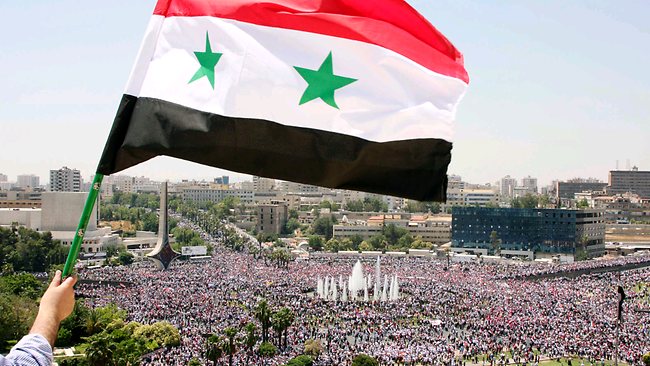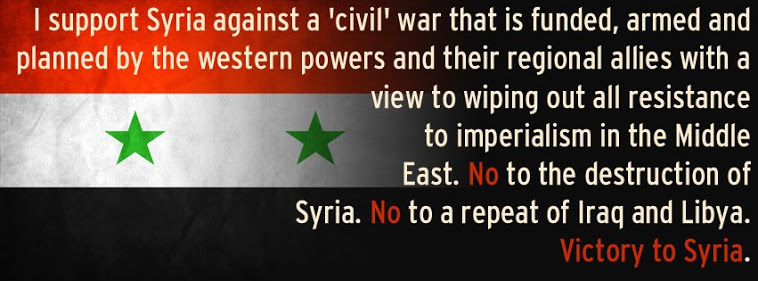The Islamic Front in Syria, as well as other jihadi groups, are working towards establishing an emirate in Syria and the Levant.
BY CLARE LOPEZ | December 8, 2013
.
| Turkish soldiers take security measures at the gate opposite of the Syrian crossing point of Bab al-Hawa. . |
During the night of December 5-6, 2013, the Islamic Front (IF), a newly-formed alliance of some 45,000 or so fighters in Syria, overran the moderate, U.S.-backed Free Syrian Army forces of the FSA’s Supreme Military Command under General Selim Idriss.
The IF fighters took control of the Bab al-Hawa border crossing from Syria into Turkey as well as a large stockpile of weapons stored in warehouses there.
The victory marked an important step in the stated direction of the IF, which, according to its charter published in late November, is committed to the formation of an Islamic emirate in the land of Al-Sham (Syria and the Levant) ruled by Islamic (sharia) law.
Many may not remember, or perhaps overlooked, a revealing interview that took place in 2005. Somehow, the Jordanian journalist Fouad Hussein was able to score that interview with Al-Qaeda’s military commander in Iran, the Egyptian Seif al-Adl.
Hussein was writing a book about the Jordanian Al-Qaeda (AQ) operative, Abu Musab al-Zarqawi, killed by U.S. forces in Iraq in 2006. His discussions with Al-Adl, however, formed what must be one of the most fascinating sections of the book, Al-Zarqawi - Al-Qaeda's Second Generation.
From his discussions with Al-Adl and other interviews, Hussein was able to construct a timeline of events that forms Al-Qaeda’s strategic blueprint. The timeline spans the 20 years between 2000 and 2020 and describes the “Seven Phases” that Hussein’s Al-Qaeda interview subjects are following en route to the eventual restoration of the Islamic Caliphate, their key objective.
Without going through each one, suffice here to highlight Phases Three through Five, because something just happened that moves Al-Qaeda and Islam one more step closer to establishment of an emirate in the land of Al-Sham (Syria and the Levant).
The Third Phase, which spanned the years from 2007-2010, was described as the “Arising and Standing Up” time. During these years, Syria, Jordan, Iraq and Israel were to be the focus of attacks by the forces of Islam.
The Fourth Phase, from 2010-2013, was identified as the time when “hated Arab governments” would be brought down. Given the strong correlation of this timeline with actual events as they unfolded in the Middle East North Africa (MENA) region, it is useful to correlate AQ activity with another series of key pronouncements that were closely aligned with these events.
In July 2010, Al-Qaeda published the first issue of its slick English-language online magazine called “Inspire.” This is the one that exhorted, “O Muslims rise up in defense of your Messenger.” TheMuslim Brotherhood’s Supreme Guide, Muhammad Badi’ responded just months later, in late September 2010, with a call to action for the “Muslim nation” and a declaration of jihad against the U.S., Israel and “Arab and Muslim regimes” that “are disregarding Allah's commandment to wage jihad for His sake…”
Two of the elements that were needed for the Islamic uprising of 2011 were now on board. The third element fell into place in January 2011 with a fatwa from Al-Azhar that declared “Offensive Jihad is Permissible.”
Thus, the fighting vanguard of Islam (Al-Qaeda), the Da’wa jihadis that subvert from within (i.e., the Muslim Brotherhood) and the Sunni theological authority (Al-Azhar) were in complete alignment by January 2011. The Islamic Uprising, aka The Fourth Phase, was underway.
Syria has posed a tougher challenge to the Saudi-backed jihadis seeking to topple President Bashar al-Assad’s regime than first expected. That is why last week’s victory by the Islamic Front alliance is significant.
The control of the Bab al-Hawa border crossing from Syria into Turkey as well as a large stockpile of weapons stored in warehouses there bring the IF one step closer to their goal of the formation of an Islamic state in Syria and the Levant.
The victory must also be viewed in conjunction with the fact that the other two major Al-Qaeda-linked militia groups in Syria -- Jabhat al-Nusra and the Islamic State in Iraq and al-Sham (ISIS) -- while not formally a part of the IF command, nevertheless consider themselves brothers in jihad -- also control large swaths of Syrian territory.
On to the Fifth Phase. According to the Hussein interview with Seif al-Adl, the period between 2013 and 2016 marks the point at which an Islamic state can be declared. The Al-Qaeda operatives with whom Hussein spoke expected that Western, and particularly, U.S. influence in the Islamic world would have been so diminished by this time, and Israel placed under so much pressure, that resistance to the declaration of an Islamic state would be minimal to non-existent.
According to the timeline, the years from 2016 onwards will see the final, all-out confrontation between the forces of Islam and whatever remains of Israel and the West.
The time when the U.S. and the West might have supported Syrian rebel forces not associated with Al-Qaeda is long gone. The Qatar- and Saudi-backed fighters from the Syrian Muslim Brotherhood showed themselves every bit as dedicated to a Caliphate and sharia as the Al-Qaeda fighters, but there were elements of the FSA dedicated to more democratic outcomes who pleaded in vain for U.S. and Western assistance while denouncing the Al-Qaeda jihadis who eventually turned on them.
U.S. leadership steadfastly refused to even speak with these FSA fighters, clearly because they were not aligned with either the Brotherhood or Al-Qaeda, the groups favored and supplied by Qatar and Saudi Arabia.
The Saudi intelligence chief, Prince Bandar bin Sultan, who boasts close ties among Washington, D.C. power players dating to his long years as Saudi ambassador to the U.S., is fighting for his life, the Saudi throne and the future of his Sudeiri Seven clan—high stakes he cannot afford to lose. The battle for Bab al-Hawa was a critical one that brought him just a bit closer to his objectives.
Meanwhile, top U.S. negotiators head to more talks in Vienna next week over the Iranian nuclear weapons program. Maybe they think an Iranian bomb will balance out the emerging Sunni Islamic emirate gradually taking shape in the heart of the Muslim world.
.
.
Clare Lopez is a strategic policy and intelligence expert with a focus on the Middle East, national defense and counterterrorism. Lopez served for 20 years as an operations officer with the Central Intelligence Agency (CIA).
...
...











